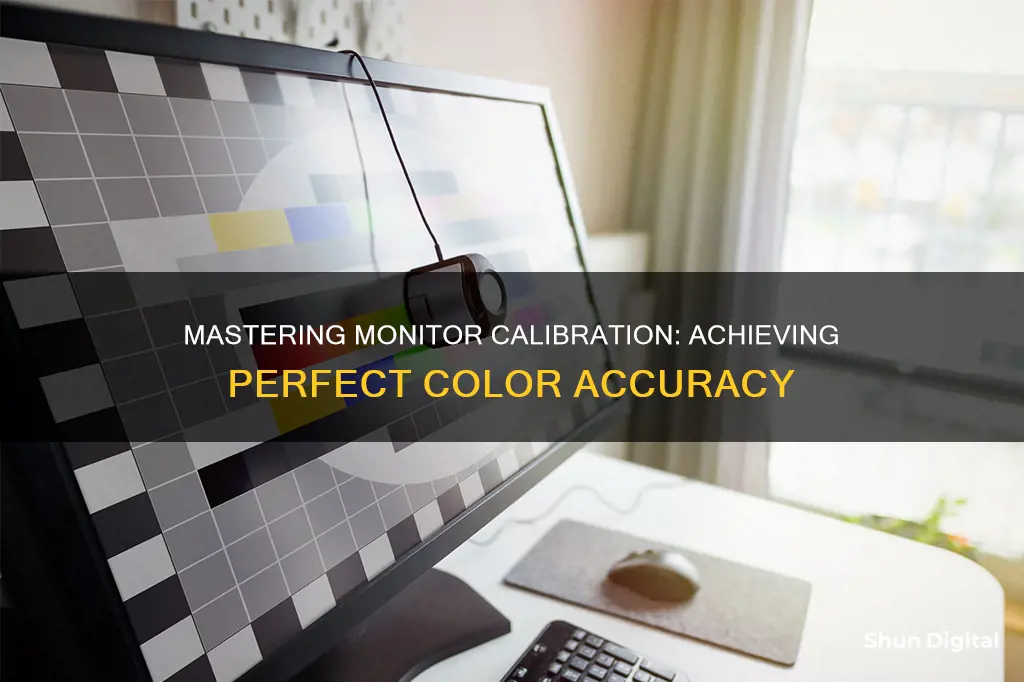
Calibrating your monitor is essential to ensure that the colours you see on your screen are accurate. Without calibration, your monitor may display colours with different hues and temperatures, affecting the consistency of your work. Calibration is especially crucial for professionals in photography, videography, graphic design, and digital art, where colour accuracy is vital. While basic monitor calibration can be achieved using built-in tools or online utilities, more precise calibration requires the use of hardware calibration tools or dedicated colour calibration software. This process involves adjusting gamma, brightness, contrast, and colour balance to align with industry standards and your specific working environment.
| Characteristics | Values |
|---|---|
| Purpose | To ensure the monitor displays colours accurately |
| Calibration Process | Aligning screen colours with the RGB (red, green, blue) colour model |
| Calibration Tools | Built-in tools, online tools, calibration software, hardware monitor calibration tools |
| Calibration Devices | Colorimeter, calibration tool, calibration device |
| Calibration Device Brands | Datacolor Spyder, X-Rite ColorMunki, X-Rite i1Display Pro, Datacolor SpyderX Pro |
| Calibration Steps | Warm up monitor, adjust lighting, specify monitor type and target settings, confirm monitor settings, automatic calibration |
| Calibration Frequency | Once a month, or when lighting changes |
What You'll Learn

Use built-in tools on your computer
Both Windows and macOS offer built-in calibration tools that are easy to use and can help you adjust your monitor's displayed colors. This method is free, requires no installation, and is a good option if you don't require a professional solution.
Windows
For Windows 11, you can find the calibration tool by opening the Control Panel and navigating to Color Management in the search bar at the top of the window. Click on the Advanced tab to find options for display calibration and select the Calibrate Display button. You will need to enter your username and password before making changes. Windows will then provide you with instructions on how to adjust your display settings, including gamma and brightness levels.
For Windows 10, you can access the calibration tool by clicking the Start Menu, then typing "Calibrate Display Color" in the search bar. Click on the first result, and the Display Color Calibration tool will open. Follow the on-screen instructions to adjust your gamma, brightness, contrast, and color balance.
MacOS
For macOS, go to System Settings > Displays and then select Color Profile. Choose any profile that fits your current display from the dropdown menu, or select Customize to create a tailored color profile. Click on the + icon to launch the Display Calibrator Assistant, which will guide you through the steps to ensure you have a properly calibrated monitor. Once you've made changes, macOS will let you save the color profile.
Lighting Conditions
Before starting calibration, ensure that the lighting conditions in your working area remain constant as changes in ambient light can affect how colors are perceived. Therefore, it's important to calibrate your monitor based on your specific working environment.
Device Monitoring Studio: What's the Deal?
You may want to see also

Use online monitor calibration tools
There are several online tools that can help you calibrate your monitor for colour accuracy. Here are some options:
- Photo Friday: This is a photography site with a simple one-page monitor calibration tool that helps you adjust the brightness and contrast of your screen using grayscale tones. The goal is to tweak your monitor settings so that you can clearly distinguish the transition of tones from true black to true white. After calibration, the blacks should appear black with no hint of grey. To use this tool, dim the lights and hit F11 to view the grayscale chart in full-screen mode, and observe your monitor from your normal viewing distance.
- The Lagom LCD Monitor Test Pages: This site offers a more comprehensive set of tools than Photo Friday, with a series of test patterns that start from checking contrast to response times of your monitor. It is recommended to go through the tests in the order they are presented. The first few images can be used to check brightness, contrast, and sharpness, and then you can move on to tests like "Viewing Angle" to see if the display changes brightness or colours in the corners.
- Online Monitor Test: This website has a range of interactive tests to fix your screen colours. The tests start with checking the brightness and contrast across the black-and-white tonal spectrum, and then move on to the "Color Range" test, which checks if your monitor can smoothly produce colour gradients. The "Trailing" test looks for "ghost images" or image trails, while the "Homogeneity" test helps to pinpoint damaged pixels and faulty monitors with backlight bleeding. The last two tests in the lineup are 1:1 Pixel mapping and testing for a blurring of text.
- Monitor Calibration and Gamma Assessment: This page and its associated test are devoted to gamma values and their importance in monitor calibration. The author provides a series of "Gamagic" test patterns that can be used to calibrate your monitor by adjusting the gamma setting with the monitor controls until all the squares match up with their backgrounds as closely as possible.
While these online tools can be helpful, it's worth noting that neither online calibration software nor the calibration tools built into your operating system will provide objectively accurate colour. These programs rely on your eye, and eyes can be subjective. If you need truly accurate colour, you may want to consider investing in a colourimeter, which is a small calibration device that fastens to your screen and works with calibration software to optimise display colour for your particular screen and lighting conditions.
Monitoring Memory Usage: CloudWatch Strategies and Insights
You may want to see also

Download colour calibration software
There are several options for colour calibration software, some of which are free and some of which require payment.
Free software
- Windows Calibrate Display Colour: In Windows 10 (and likely older versions), click 'Start' and type "calibrate" to bring up the "Calibrate Display Colour" wizard. This is a useful and easy-to-use tool, but it won't get you anywhere near 100% accuracy.
- Lagom: This is a free online tool that uses test images to help you approximate certain settings.
- Dead Pixel Buddy: A free online tool for searching for dead pixels. Just go full-screen with your browser (typically F11), click a sample colour, look for dead/stuck pixels, then proceed through the other colours.
- TestUFO: A free online tool to test a number of aspects of monitor performance.
- DisplayCAL: This is a free, open-source, and powerful tool that can be used instead of the included software that comes with colour calibration hardware.
Paid software
- Calibrize: A nice, free program only available for Windows, that is part of the category Software utilities with subcategory Analysis & Optimization.
- Auralisoft Display Calibration: A paid software that helps you calibrate your monitor more easily.
Colour calibration hardware
If you want to accurately calibrate your monitor, you'll need a hardware tool. Here are some budget-friendly options:
- Good: Spyder 5 Express (~$1200)
- Better: X-Rite ColorMunki (~$180)
- Best: X-Rite i1 Display Pro (~$230)
Design Monitors: Worth the Investment?
You may want to see also

Get a hardware monitor calibration tool
If you are looking for the most accurate way to calibrate your monitor, a hardware monitor calibration tool is the way to go. These tools, also known as colorimeters, are small devices that attach to your screen and work with calibration software to fine-tune the display colour for your specific monitor and lighting conditions.
Colorimeters are especially useful if you are working in photography, videography, or any other field where colour accuracy is important. They can help you avoid unintentionally sharing photos that are oversaturated, too muted, or have a noticeable colour cast.
There are a variety of colour calibration tools on the market, and the right one for you will depend on your specific needs and budget. Here are some popular options:
- Datacolor Spyder series: This is a popular option, with models available for both beginners and professionals. The SpyderX Pro is a fast calibration tool with a lens-based sensor system, while the SpyderX Elite offers advanced features like the ability to calibrate to specific colour space standards.
- Calibrite ColorChecker series: These tools are known for offering all-in-one solutions. For example, the ColorChecker Studio combines monitor and printer calibration into a single device. The ColorChecker Display Pro is designed for those who want top-notch calibration as quickly as possible and offers extensive customisation options.
- X-Rite ColorMunki: This device will measure the ambient light in your room and recommend optimal calibration settings.
- Wacom EODIS3-DCWA Color Manager: This tool supports LCD, LED, and wide-gamut displays and includes software for both iOS and Android mobile devices.
When choosing a monitor calibration tool, consider factors such as speed, ambient light detection, and compatibility with your specific monitor type. Additionally, keep in mind that calibration is an ongoing process—professionals recommend calibrating your display at least once a month to maintain colour consistency.
LCD Burn-In: Myth or Reality?
You may want to see also

Calibrate based on your working environment
Calibration is the process of aligning your screen's colors with the standards set by the RGB (red, green, blue) color model. This model is the standard for most TVs and computers. Calibration ensures that the colors on your display are consistently aligned with the actual product.
Before calibrating your monitor, it is important to get it, and the space around it, ready. Firstly, turn on your monitor at least half an hour before calibration so it can warm up to its normal operating temperature and conditions. Secondly, set your monitor's resolution to its native, default screen resolution. Thirdly, ensure you are calibrating in a room with moderate ambient lighting. The room doesn't need to be pitch black, but you don't want the sharp glares and color casts resulting from direct light. Lastly, familiarize yourself with your monitor's display controls. They may be located on the monitor itself, on the keyboard, or within the operating system control panel.
The lighting condition in your working area should remain constant as any changes in your ambient light may affect how you or the calibrating machine will see colors. That's why you should calibrate your monitor based on your working environment.
Both Windows and macOS have built-in calibration tools to help guide you step-by-step through the process. These free tools should be the first stop if you're merely a casual image junkie or working on a tight budget. In the latest versions of Windows, the easiest way to find the color calibration tool is through the Windows search bar. Type "calibrate" into the search bar and select "Calibrate display color" from the results. On Windows 10, search for "Color Calibration" and select the corresponding result. In older versions of Windows, you can find the Color Calibration utility in the Display section of the Control Panel, which is listed under Appearance and Personalization.
Once you are in the calibration tool, follow the on-screen instructions to choose your display's gamma, brightness, contrast, and color balance settings. A sample image for you to match will accompany many of the settings. Simply make adjustments to mimic the sample as closely as possible. Once the calibration wizard is complete, make sure to choose the Current calibration or return to the previous calibration if you are unsatisfied with the results. The new calibration will be stored as an .ics file, or color calibration file, and will show up as a new International Color Consortium (ICC) Profile in the Color Management settings app.
The easiest way to open this app is to type "color management" in the search box and choose the first result. Once it's open, you can select your monitor from the device list and see which ICC Profiles are available.
Maintain Consistent Volume: Studio Monitors
You may want to see also
Frequently asked questions
Monitor calibration is the process of aligning your screen’s colours with the standards set by the RGB (red, green, blue) colour model. This model dates back to the nineteenth century but is still the standard for most TVs and computers.
There are several ways to calibrate your monitor. You can use your computer's built-in tools, online monitor calibration tools, download colour calibration software, or get a hardware monitor calibration tool.
Professionals recommend calibrating displays at least once a month to ensure colours stay consistent, especially as your monitor degrades and its colours change over time.
Calibration ensures the colours you see on your screen are accurate. If your display doesn't show the correct colours, what looks natural to you might have different hues and temperatures when viewed on other devices or when printed.







